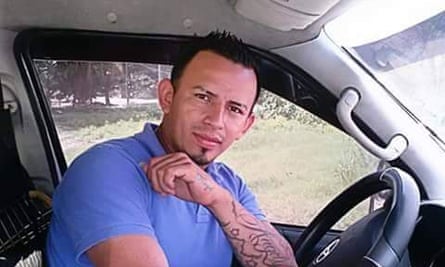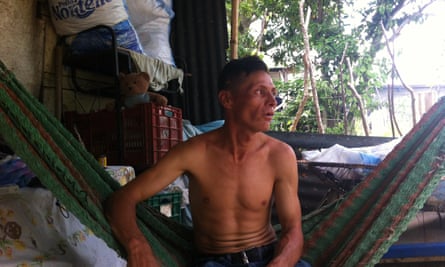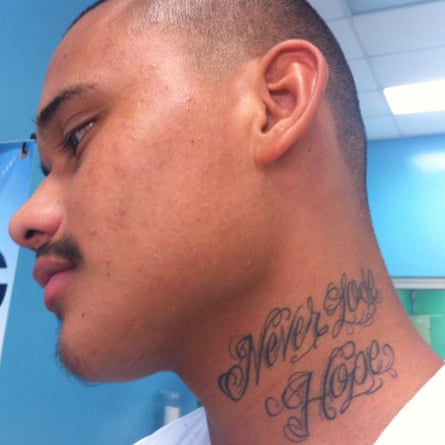When Antonio Díaz’s 26-year-old son Oscar was kidnapped, beaten and left for dead by gang members, the Honduran father decided to send Oscar and his three brothers to the United States, fearing that any one of them could be the next victim of the country’s swelling wave of violence.
“I sent them away for their safety,” says Díaz, sitting in a comfortable and well-furnished three-bedroom home in a town outside San Pedro Sula, where he owns a fleet of minibuses. “We’re not bad off here, economically, but I couldn’t bear the thought of my sons getting killed,” he says.
A year and a half after Antonio paid the $6,000 coyote fee for each of his sons to make the perilous overland journey to the United States as undocumented migrants, one of the young men – Ángel – was deported back to Honduras.
A month later he was dead, gunned down on one of his father’s buses by suspected gang members.
“After he was sent back here, I was afraid whenever he left the house,” says Antonio, who asked that his real name not be used for fear of retaliation from the gangs, known here as maras. “And they killed Ángel just as I’d feared,” he says.
Every year hundreds of thousands of Hondurans, Guatemalans and Salvadorans flee poverty and violence at home in search of a better life in the United States. And every year tens of thousands of undocumented migrants are sent home.
In the 2015 fiscal year, which ended in September, 231,000 undocumented immigrants in the United States were reportedly deported, according to the Associated Press. In the year to 27 July, 10,333 of those had arrived in Honduras.
For deportees such as Ángel who fled their country out of fear for their lives, returning home can mean death.
No one keeps an official record of how many returnees have been murdered in Honduras. But a review of news reports of killings in the country compiled by researcher Elizabeth Kennedy at theSan Diego State University shows that at least 35 people who were deported from the United States between January 2014 and July 2015 were murdered within months – or even days – of their arrival in Honduras.
One homicide detective in San Pedro Sula told the Guardian he estimated that deportees accounted for 10 to 15% of the cases he investigates in the city, which for the past three years has been the most violent in the world.
The Guardian tracked down the families of three men killed in the past year shortly after being deported from the United States and also documented the murder of one 14-year-old boy forcibly returned from Mexico.
Their stories highlight the risks many deportees face on their return.
‘They killed Ángel’
Despite fleeing that violence, neither Ángel Díaz, 26, nor his brothers requested asylum when they arrived in the United States, preferring to keep their heads down. Ángel found a job in construction and was settling into his new life. But in April 2015 he was arrested following a domestic dispute with his girlfriend and – since he had no residency papers – he was sent to a detention centre for deportees.
After three months in detention, he was back in the violence-plagued town he had fled.

Resigned to his forced repatriation, he asked his father, Antonio, to give him a job driving one of his minibuses. Antonio says he feared that Ángel was taking a risk. “I didn’t want him to expose himself like that but he needed to work,” he says.
Antonio had been paying the maras 300 lempiras (about $13) per bus each week, so he hoped there would be no problems.
There was no warning. On July 13, just days after his return, Ángel was gunned down in the driver’s seat of his bus.
A few days after Ángel’s funeral, Antonio dropped off his son Oscar, who had returned home for a visit; his daughter-in-law; and four grandchildren at the border with Guatemala, paying a coyote to get them safely to the United States.
“We are all going. We realized we can’t stay here anymore,” he says, adding that he and his wife hoped to join the rest of the family as soon as he could sell his business.
Armed with the records documenting his brother’s murder, Oscar and his wife requested asylum at the Texas border. Oscar’s wife and her three children were given a one-year permit to stay, while Oscar was taken to a detention centre in Miami, he says. Antonio’s other grandchild, the nine-year-old boy of another son, was taken to New York for processing.
A review by the UN refugee agency (UNHCR) of intake interviews of deportees to Honduras in the second half of 2013 found that only 5.3% stated “threats” or “insecurity” as their reason for leaving Honduras. However, UNHCR reckons the number may be underreported given limitations of the interview process, underscoring that the decision to migrate is based on multiple factors.
‘The gang they escaped will kill them’
José Marvin Martínez, known to friends, neighbors and family as El Chele, which means “blondie”, probably wouldn’t have cited insecurity as his reason for leaving San Manuel, a town near San Pedro Sula, in 2012. He told his oldest brother, Hipólito Díaz, that he was tired of being poor and wanted to find work in the States.
But the decision came just a few months after another of their brothers, Rigoberto, was gunned down by suspected gang members near their parents’ home in 2012. “I think it had something to do with that,” says Díaz, sitting in a tattered hammock in the back of his home made of rusty sheet metal.

El Chele, who migrated at the age of 16, found a job as a mason’s assistant in Houston. By the time he was deported in August 2014, he’d managed to save some money and, on returning to live with his brother, bought a motorcycle.
Neighbours say they believed that once he was back in Honduras, El Chele had gotten involved with the maras that control the area. “I don’t know if he was mixed up in something bad but I wonder what he did on the street all the time,” Díaz says.
Díaz had tried to convince El Chele to go back to the family farm in Lempira province to try to keep him out of trouble. El Chele promised he would go after the Christmas holidays.
But on 14 December 2014, El Chele was sitting in front of a corner store chatting with a friend when gunmen in a red truck opened fire on him, killing him instantly. “I got there a half hour after he’d been killed. He was lying face down in the street,” says Díaz. Police told him they found 20 bullet casings at the scene.
For young people in Honduras, joining local gangs – either by choice or by force – is one of few life options they have. Detective Jaime Coto says many of the minors who leave for the States are trying to escape being forcibly recruited into the gangs,or if they’ve already started working with the maras, leaving the country may be their only way out.
“When they are deported back here, it’s dangerous for them to go back to where they left because the gang they escaped will kill them.
“If a deportee can’t find a place to feel safe, surely he’ll be killed,” says Coto, one of an overstretched and underfunded team of investigators who police most of Cortés province, which includes San Pedro Sula. Twenty-six detectives share one vehicle to police the region, which has a population of around 1.3 million. Between four and eight murders are reported on their patch every day.
Gredis gunned down
Fewer than 2% of murders in Honduras result in conviction. But in the case of Gredis Alexander Hernández – a 14-year-old boy who was gunned down just days after being deported from Mexico – police can claim a rare victory.
Hernández had fled Honduras with his 16-year-old sister after witnessing the murder of his sister’s boyfriend, according to police. They were both deported days after leaving and initially placed in a home for returned minors.
Hernández persuaded authorities to allow him back with his family; two days later he was shot twice in the head as he lay in his bed. After his murder, his sister escaped the group home and once again left the country, police say.
In mid-September, police captured three gunmen accused of Hernández’s murder. A fourth is still at large.
‘The evil there is tremendous’
Juan Francisco Díaz was also planning to leave Honduras again, after having been deported from the United States to the town of Choloma in March. He’d lived undocumented for three years in the US before being picked up for drunk and disorderly conduct, according to his father, who asked to be identified as Héctor.
Juan Francisco, 34, had trouble finding work after being returned to Honduras and had already made arrangements to make the harrowing overland journey back to the United States in mid-July. On 5 July, he was found dead in an alleyway of his parents’ neighborhood. “Neighbors knocked on my door to say they had recognized the body as my son,” Héctor says.
After burying their son, he and his wife fled to another part of Honduras, out of fear. “The evil there is tremendous. We are afraid to go back,” Héctor says in a telephone interview.
At least twice a week, every week, a planeload of new deportees arrives at the San Pedro Sula Airport’s Centre for the Attention to Returned Migrants (CAMR) where all adults sent from the United States are processed on their return to Honduras.
As they file off the plane and into the reception centre they are handed a coffee and a bean-filled wheat flour tortilla, a popular local treat called baleada which translates roughly as “one who’s been shot”.
There, banners in English greet the men and women whose lives have just been upturned offering opportunities to start over. “You can also live your American dream in Honduras”, reads one sign, offering them jobs in call centres for US companies.
Volunteers at the centre pile up red mesh bags with the few belongings that the deportees bring with them. Some come with a several changes of clothes while others have nothing but a few scraps of paper, a comb and some plastic containers.
On recovering their personal effects, they begin tying their shoes with newly recovered laces and looping belts through their sagging pants.
Dora Melara, a legal adviser who works with the recently arrived deportees, says most of them will turn right around and go back to the lives they left behind in the States. “It’s hard to tell someone who migrated because of threats to stay,” she says.
And for those who have been away for a long time, learning to navigate the social and criminal landscape of the country can be just as perilous as the overland journey to the US border.
On a recent afternoon, Alberto García, 20, seemed a bit stunned at being back in a country he barely knew: his mother took him to the United States when he was just five years old. But the tattoo on his neck proclaimed his motto – “Never lose hope” – and García said he was planning to put his fluent English to use at a call centre.

García, who worked as a forklift driver in California, said he’s aware of the dangers in Honduras, but intends to keep his head down and wait until his mother is granted citizenship in the US, so that she can request a green card for him as part of a family reunification plan.
But most who have made their lives in the States just want to get back.
Carlos Fonseca was only six when he left Honduras for the United States with his mother. Now the 31-year-old, who speaks perfect English and slightly accented Spanish, only has some distant relatives left in San Pedro Sula. His wife and children are in the US.
When he was detained in California in February, he requested asylum, but after six months in a detention centre he decided to accept deportation. “I was sick of being locked up,” he says.
Outside the returned migrant centre, he looked nervously for a taxi. “Let’s get an old man driver,” he told his companion. “Someone who won’t mess with me.
“The minute I can arrange things, I’m headed back home,” Fonseca said. “I’ve heard it’s dangerous here, man.”

Comments (…)
Sign in or create your Guardian account to join the discussion